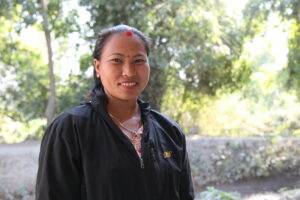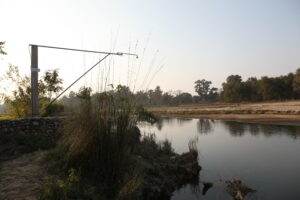An alternative approach to recovering from floods in Nepal
How can lives and livelihoods affected by floods can not only be protected but ensured of a better future through a safe recovery? Richa Gyawali, our Business Development Officer in Nepal, explains a path towards it through index-based flood insurance (IBFI) and shares the voices of the farmers in the Terai region.

Bideshini Tharu
“I am getting the insurance again; in fact, I will insure my entire plot of land” – Bideshni Tharu, smallholder farmer
This sentiment was echoed by many of the smallholder farmers I met during a visit to the Terai in Western Nepal to understand better the impact of a recent pilot project to provide index-based flood insurance (IBFI). The easy and hassle-free insurance process, timely payout and a fair mechanism were some of the reasons given for the enthusiasm.
What is different about this insurance?
In most insurance policies, where payouts are based on recorded losses, it is challenging for smallholder farmers to make claims. Much paperwork is needed, and many complain that the process is not transparent enough, so farmers can’t be confident they’ll be compensated for their losses even if they’ve paid their premiums and followed the claims process.
However, index-based, or parametric, flood insurance is a type of insurance where policyholders receive compensation when the threshold for pre-agreed parameters, like levels of flood or rainfall, are met. This makes the return on the investment into insurance clearer.
Tirtha, Chairman of a local ward, explained the different experiences between index-based and traditional indemnity insurance. She said: “People did not trust the insurance policy before. In traditional insurances, there is always a delay in the payout. The process for compensation is lengthy, from getting approval from the wards, taking the documents to places, time to wait, policy report, etc. Index-based insurance is hassle-free and timely.” While Santa, a resident of Munuwa added, “The community members received the payout in the time span of two weeks to a month, right on time to buy crops and fertilisers for another season.”
An ideal location for testing a new insurance product

A telemetry station constructed on the bank of the Aurahi River, Nepal
Communities living near the mighty Karnali river in Western Terai are impacted by floods every year during the monsoon season. The same river that makes the Terai a fertile farming area often inundates fields, sweeping away crops and livestock and damaging houses and sheds.
Tika expressed the challenges well. “The entire village, friends, and communities are in a state of need during the flood, leaving us with no one to seek help from. In such a situation, waiting for relief to recover from the loss is rather uncertain.” She added, “In the case of index-based insurance, it is different. We invest some money and the compensation we get provides decent support to us in such difficult times”.
Tika’s reflections suggest that IBFI can play an important role in building flood resilience among vulnerable smallholder farmers. However, successful implementation depends on the contribution and collaboration of different stakeholders- communities, insurance companies, cooperatives, and local government. An overview of the different stakeholders we’re working with and their different roles can be found in this short project brief.
Local farmers’ cooperatives as key project partners
Local farmers’ cooperatives play a crucial role in the rollout and success of this project.
Cooperatives educate local farmers about the insurance policy, how it works and what the benefits and costs are. They also act as the policyholder, working as a bridge between the farmers and the insurer. Farmers pay the cooperative, which purchases a joint policy from the insurer.
When floods happen, as they did in the autumn of 2022, the cooperatives are responsible for alerting their members when a trigger for payout has been reached and paying each farmer what they are owed. This takes a lot of the hassle out of buying insurance and making a claim for the individual farmer.
Cooperative organisers expressed strong ownership of the IBFI process and played an essential part in building trust in insurance policies.
The future of index-based flood insurance in Nepal
Many of the people I spoke to see this pilot as a success and are keen to purchase the insurance again or for the first time after seeing the benefits to friends and neighbours.
However, despite people’s interest and positive attitude, the insurance policy is an expensive investment for poor community members living on the banks of the river. Bideshni told me: “We would want to insure our entire land, but due to our economic condition, paying the premium is not easy. In such a case, a subsidy to the extremely poor would be a boon.”
IBFI can be an innovative approach that helps communities prepare for floods and recover sooner. Visiting communities in the Terai and understanding their realities made me acutely aware of the importance of preparing for floods before they happen, not just waiting to respond once the disaster has hit.
Learn more about index-based flood insurance in action here.
Author

Richa Gyawali, our Business Development Officer in Nepal